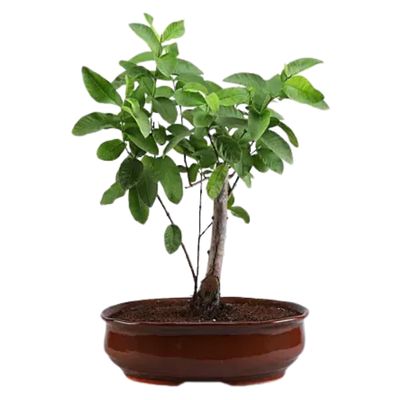
Common Guava
(Psidium guajava)
Country of Origin : Central and South America
Bonsai Styles : Informal upright
Zone : 9 – 11
In almost all warm regions, the common guava or apple guava can be found today. The plant grows in the tropical zones of the Americas.
The bark has a flaky and smooth texture. From time to time, small pieces of bark are shed. Its color ranges from light to dark green.
This plant has four-sided shoots when they are young.
The plant has opposite, oval leaves that are covered in a downy covering on the underside, and it produces white flowers from the axils of the leaves.
The fruit has the shape of a pear and can range in length from 1.5 inches to 4 inches (4 cm to 10 cm).

The flower of common guava is similar to flower of Strawberry Guava bonsai tree.
The showy, white flowers will appear on a tree which is at least 2-3 years old.
Best location to keep Guava Bonsai
In the summer, keep the guava bonsai tree outdoors in a sunny and warm place (with no drafts). It needs a minimum light of 2000 Lux. Please read grow bonsai indoors using grow lights for more details.
This tree is also suitable for an indoor bonsai tree. When keeping the tree indoors, keep the bonsai container in an area that is as bright as possible during the day.
A west or south facing window or windowsill is a good location. At least 6 hours of sun light and shade in the afternoon.
For the winter months, it is recommended that you keep it in a bright location with a temperature range between 53°F and 64°F (12°C and 18°C).
For the rest of the growing season, a temperature range of 68°F to 86°F (20°C-30°C) is acceptable. However, a range of 73°F to 82°F (23°C – 28°C) is ideal.
This tree grows best outside during the late spring to early summer.
IMP: Refer sunlight requirements for indoor plants for more indoor gardening ideas. Also, refer to do bonsai trees need sunlight for more indoor and outdoor bonsai location ideas.
Propagation of Guava
Common guava can be propagated by using seeds or stem cuttings.
The seeds will germinate in about 3 weeks. It is worthwhile to remember that if grown from seeds, the tree may not come to fruiting for about 3-8 years.
For propagating the tree from stem cuttings, take 6-8 inches of hardwood cutting. Apply some rooting hormone and plant it in a sterile growing medium.
Keep it in a temperature of 77°F (25°C) or so.
As soon as rooting occurs, transfer it to a pot.
Watering Guava Bonsai
Guava tree has high Drought tolerance. However, in pots, the soil tends to dry up more quickly. Hence maintaining a good watering routine is always advisable.
During the growing season, make sure that the soil is kept uniformly moist. But not over watered. Avoid “wet feet.”
During the winter, Psidium guajava bonsai keeps its leaves. Hence, it will need a little bit of water during this time of the year.
It is important to keep in mind, however, that the cooler the location, the less water will be needed.
Read watering bonsai tree for more details.
Wiring Guava Bonsai
You can wire this bonsai tree at any time of the year.
If it is necessary to wire, make sure you do so only when the shoots have become lignified. (semi-woody)
Use soft aluminum or copper wires.
Pruning Guava Bonsai
When to prune Guava bonsai?
How to prune Guava bonsai?
Pruning should be carried out prior to the onset of new growth on the branches.
For a young bonsai, you should prune new shoots when they have developed five pairs of leaves, cutting those back to two to three pairs at a time.
When a bonsai is older, cut back continuously to one pair of leaves after three pairs of leaves have formed.
You can also cut off the largest leaves of the plant if the plant grows vigorously.
Since this tree naturally grows a lot of branches and twigs, regular pruning will help you in maintaining the desired bonsai style.
Remove dead and diseases branches to let air and light enter the inner sections of the bonsai.
If there is a branch with an unnatural twist or turn, remove it. If you have branches that are growing vertically and are too thick to bend, you should remove them.

While pruning thick branches, you should use a good concave cutter because the wounds that this cutter leaves behind will heal much faster and much better than the wounds left behind by a normal cutter.
Repotting Guava Bonsai
When to repot Guava bonsai?
Psidium guajava bonsai tree can be repotted every 2 years.
You can repot the tree in early spring or when the tree begin to show signs of new growth.
Guava is able to tolerate root pruning well. Make sure not to remove more than 1/4th of the total root system.
This species prefers slightly acidic soil. pH level of 4.5 to 7.
It is important that the soil be porous so that water can run through it easily, so as to prevent “wet feet”.
You can use a basic free-draining acidic bonsai soil mix as a potting soil.
OR
Use a soil mix with sand, peat moss and loam at the ratio of 1:3:1.
Must Read: Bonsai Soil Recipes
Must read : Choosing the right bonsai container
Feeding Guava Bonsai
During the growing period of the bonsai tree, you should use bonsai fertilizer once a month.
You should cease fertilizing just before flowering begins, and you should not fertilize again until the fruit has matured.
It is recommended that you fertilize once a month at half strength until spring when the growth slows down in winter.
You can also add some soil acidifier. Because these trees prefer soil with a pH of 4.5-7.
Read more about bonsai fertilizer and its application.
Diseases and pest of Guava Bonsai
Fruit flies are the major pest of this tree.
Guava moth and Caribbean fruit fly can damage the fruit of the tree. Cover the fruit or use an appropriate control agent.
Spraying the bonsai with fenthion or using bait sprays can provide additional means of controlling the pest.
Red-banded thrips and Guava whitefly can also attack the leaves of the tree. It can cause defoliation.
Other insects which can attack the tree are Mealybugs, scales and caterpillars.
The damage caused by leaf-eating caterpillars and beetles on young trees can be serious; early detection with spot treatment makes control much easier. You can remove them manually.
The control of ants can largely prevent sucking insects such as scales, mealy bugs and thrips.
An effective way to manage ants is to set natural traps made of boric acid and sugar water. This prevents them from climbing the tree.
Guava bonsai care
If you see your tree wilting, there is a high chance that the tree is suffering from root rot. If not taken care of in a timely manner, the tree will definitely die.
Choose a bonsai pot which is at least 3 gallons, to give the roots ample of space to grow. (if you want to avoid changing the pot while repotting).

